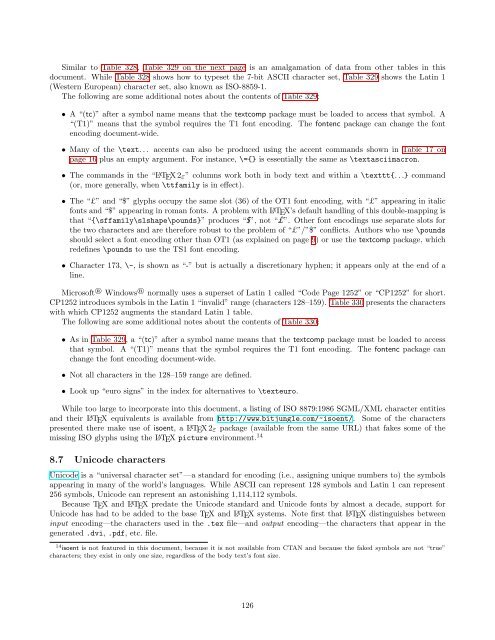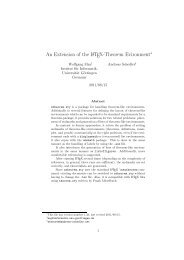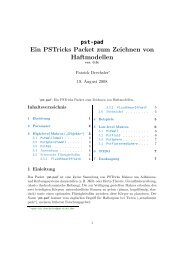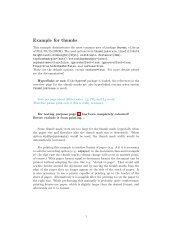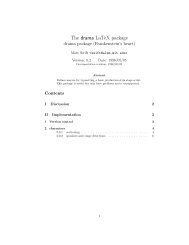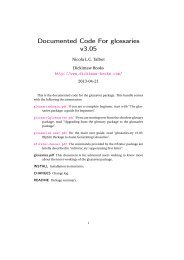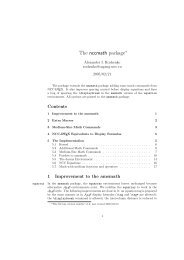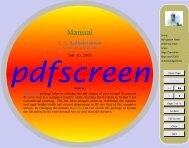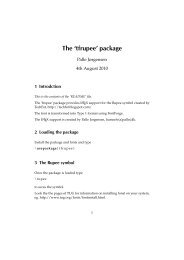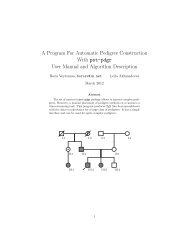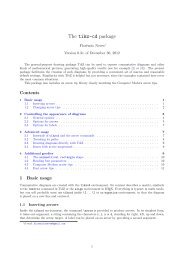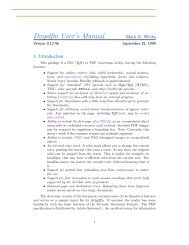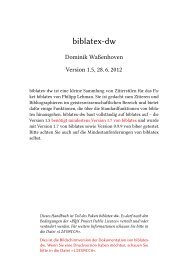The Comprehensive LaTeX Symbol List - CTAN
The Comprehensive LaTeX Symbol List - CTAN
The Comprehensive LaTeX Symbol List - CTAN
You also want an ePaper? Increase the reach of your titles
YUMPU automatically turns print PDFs into web optimized ePapers that Google loves.
Similar to Table 328, Table 329 on the next page is an amalgamation of data from other tables in this<br />
document. While Table 328 shows how to typeset the 7-bit ASCII character set, Table 329 shows the Latin 1<br />
(Western European) character set, also known as ISO-8859-1.<br />
<strong>The</strong> following are some additional notes about the contents of Table 329:<br />
• A “(tc)” after a symbol name means that the textcomp package must be loaded to access that symbol. A<br />
“(T1)” means that the symbol requires the T1 font encoding. <strong>The</strong> fontenc package can change the font<br />
encoding document-wide.<br />
• Many of the \text. . . accents can also be produced using the accent commands shown in Table 17 on<br />
page 16 plus an empty argument. For instance, \={} is essentially the same as \textasciimacron.<br />
• <strong>The</strong> commands in the “L ATEX 2ε” columns work both in body text and within a \texttt{. . .} command<br />
(or, more generally, when \ttfamily is in effect).<br />
• <strong>The</strong> “£” and “$” glyphs occupy the same slot (36) of the OT1 font encoding, with “£” appearing in italic<br />
fonts and “$” appearing in roman fonts. A problem with L ATEX’s default handling of this double-mapping is<br />
that “{\sffamily\slshape\pounds}” produces “$”, not “£”. Other font encodings use separate slots for<br />
the two characters and are therefore robust to the problem of “£”/”$” conflicts. Authors who use \pounds<br />
should select a font encoding other than OT1 (as explained on page 9) or use the textcomp package, which<br />
redefines \pounds to use the TS1 font encoding.<br />
• Character 173, \-, is shown as “-” but is actually a discretionary hyphen; it appears only at the end of a<br />
line.<br />
Microsoft ® Windows ® normally uses a superset of Latin 1 called “Code Page 1252” or “CP1252” for short.<br />
CP1252 introduces symbols in the Latin 1 “invalid” range (characters 128–159). Table 330 presents the characters<br />
with which CP1252 augments the standard Latin 1 table.<br />
<strong>The</strong> following are some additional notes about the contents of Table 330:<br />
• As in Table 329, a “(tc)” after a symbol name means that the textcomp package must be loaded to access<br />
that symbol. A “(T1)” means that the symbol requires the T1 font encoding. <strong>The</strong> fontenc package can<br />
change the font encoding document-wide.<br />
• Not all characters in the 128–159 range are defined.<br />
• Look up “euro signs” in the index for alternatives to \texteuro.<br />
While too large to incorporate into this document, a listing of ISO 8879:1986 SGML/XML character entities<br />
and their L ATEX equivalents is available from http://www.bitjungle.com/~isoent/. Some of the characters<br />
presented there make use of isoent, a L ATEX 2ε package (available from the same URL) that fakes some of the<br />
missing ISO glyphs using the L ATEX picture environment. 14<br />
8.7 Unicode characters<br />
Unicode is a “universal character set”—a standard for encoding (i.e., assigning unique numbers to) the symbols<br />
appearing in many of the world’s languages. While ASCII can represent 128 symbols and Latin 1 can represent<br />
256 symbols, Unicode can represent an astonishing 1,114,112 symbols.<br />
Because TEX and L ATEX predate the Unicode standard and Unicode fonts by almost a decade, support for<br />
Unicode has had to be added to the base TEX and L ATEX systems. Note first that L ATEX distinguishes between<br />
input encoding—the characters used in the .tex file—and output encoding—the characters that appear in the<br />
generated .dvi, .pdf, etc. file.<br />
14 isoent is not featured in this document, because it is not available from <strong>CTAN</strong> and because the faked symbols are not “true”<br />
characters; they exist in only one size, regardless of the body text’s font size.<br />
126


